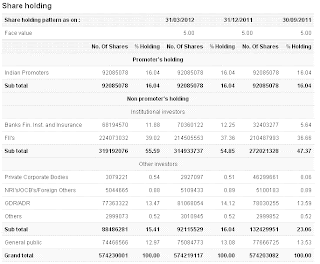Amidst all the negative news flows and talks of changed
sentiments toward bellwether IT Largecap stock Infosys Ltd, it’s a difficult
statistics to believe that FII holding in this particular scrip has actually
gone up from 36.66% two quarters ago, to 37.36% one quarter ago to a whooping
39.02% in the quarter gone by.
Thus FIIs own greater pie of Infosys stock than
any other entity taken individually. In the same time-period, Indian public shareholding
in Infosys has continuously fallen, from 13.53% to 13.08% to 12.97%. Now, FIIs
are a bunch of real pros, whose job is to analyze the market, and take buy/sell
decisions after much in-depth analysis, whereas common public often buys or
sells stocks based on sentiments or what’s published in broker stock reports or
newspapers, which is again primarily sentiment driven.
So what’s the real story behind the scenes? Why are FIIs so bullish, whereas rest of world is negatively reacting to Infosys? Let’s look at data and analyze.
In the quarterly results just published two days back,
Infosys Net Profit Margin has been a whooping 31.38% which is higher number
than any of the past 5 quarters taken individually. On a annual basis, the
profit margin has been 25.6% which is higher margin than 2011 numbers of
24.28%. Comparing these numbers to market competitors, TCS’s Net margin for 2011 was at
a comparable 25.43% and for HCL Tech, it was at a paltry 17.21% for 2011. 2012
results are yet to be published and we will write a addendum when it finally
gets out in few days time.
But, being a value investor we need to figure out whether
buying Infosys as a whole makes sense and how much one needs to pay for that. Total
Market Cap of Infosys is at Rs 1.36 Lakh Crore, which is much lower that TCS,
which is trading at a whooping Rs 2.09 Lakh Crore. Thus you need to pay 54%
more money to buy TCS, which just gives you a company whose 2011 Net profits were
18% higher than Infosys or revenues were 16% higher than Infosys. Why do you
want to pay 54% higher for just 18% higher profits. First rule is Value Investing
is not to overpay, second rule is to look at rule one when in confusion.
Let’s look at another value parameter, simple P/E ratio. At
current prices, Infosys is trading at P/E ratio of just about 16.3, whereas TCS
is trading at PE ratio of 27.65 and even HCL Tech is trading at high PE ratio
of 27.48. Wipro is trading at much higher PE of 21.33 inspite of lower revenues
and net profit margin of just about 18%. Infosys PE ratio is now getting
comparable to midcap IT firms like Hexaware or Tech Mahindra which deliver much
lower revenues and profitability. Sentiments are totally at play here, not data
and raw facts.
One more important parameter is when you buy into Infosys, you buy into a firm holding Rs 15000 Crores of Cash funds, whereas TCS has a paltry Rs 500 crores and Wipro has a lower Rs 5000 crores of funds. Financial prudence pays in tough times and helps firms take right investment calls and helps in future growth.
To summarize, value investing is all about ignoring negativity and sentiments and analyzing hard data to make the right investment decisions. A few good quarterly results can change sentiments and deliver tremendous profits to patient and contra investors. Thanks for reading this article.



Let me help you with definitions, in case you lazy to do the calculations:
ReplyDelete1. Market capitalization (often simply market cap) is the total value of the tradable shares of a publicly traded company
2. Shares outstanding are shares that have been authorized, issued, and purchased by investors and are held by them. They should be distinguished from treasury shares, which are shares held by the corporation itself.
3. A treasury stock or reacquired stock is stock which is bought back by the issuing company, reducing the amount of outstanding stock on the open market ("open market" including insiders' holdings).